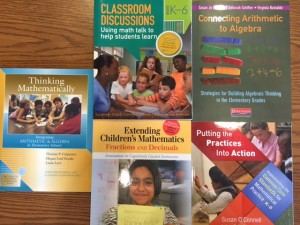Fran began the morning by sharing a number of resources:
- Thinking Mathematically: Integrating Arithmetic and Algebra in Elementary School by Thomas P. Carpenter, Megan Loef Franke, and Linda Levi. (www.heinemann.com)
- Classroom Discussions: Using Math Talk to Help Students Learn by Suzanne H. Chapin, Catherine O’Connor, and Nancy Canavan Anderson. (mathsolutions.com)
- Extending Children’s Mathematics: Fractions and Decimals by Susan B. Empson and Linda Levi. (www.heinemann.com)
- Connecting Arithmetic to Algebra: Strategies for Building Algebraic Thinking in the Elementary Grades by Susan Jo Russell, Deborah Schifter, and Virginia Bastable. (www.heinemann.com)
- Putting the Practices into Action: Implementing the Common Core Standards for Mathematical Practice K-8 by Susan O’Connell and John SanGiovanni. (www.heinemann.com).
We went deep into the homework on processes, comparing answers and pulling out some solid lessons on how to invert multi-step processes. Along the way we also established the convention that a number-based process is most generally written by using a single-letter variable as the initial input. Jen also made the connection between finding inverses and fact families: effectively we have a two-member fact family when we write a process and its inverse.
After the break we finished the discussion of the rice-and-water problem and how inverses play out there. The original problem asked “Given R cups of rice, how many (W) cups of water do we need?” The inverse problem asked “Given W cups of water, how many (R) cups of rice can that make?” We ultimately came up with formulas for converting between R and W in terms of multiplying by a rate (the exact number we multiplied was 5/3 or 3/5 depending on whether we started knowing R or W). By drawing both relations on the same axes (with different sets of labels), we drew an important geometric connection between a proportional relationship and its inverse. Specifically, the graph of the inverse formula looks like the reflection across the line y=x (which can also be seen as the 45-degree line when two axes have the same scale, also the line through (1,1), (2,2), (3,3), etc).
The remainder of the math discussions (morning and afternoon) centered around the problems in Unit FA-3 on Currency Conversion, both with and without an exchange rate. This provides a vivid contrast between proportions (without exchange rate) and the more general idea of a linear relationship (with exchange rate.
The pedagogy discussions centered around “focusing versus funneling” question styles, and using student knowledge to guide your process. After a discussion of what these terms mean, participants broke into pairs and engaged in role-playing exercises. Partners recorded themselves as they took turns acting as students (who made errors) and their teacher. The homework is to listen to one’s turn as teacher and analyze one’s teaching style.
Math Homework
Complete all 12 problems under the “Currency Conversion Problem with Exchange Rate”
Read pages FA3.9 to 10, on the terminology of linear relationships.
Pedagogy Homework
Listen to the audio-recording of your teaching episode. In your notebook, write down the questions that you asked.
In Principles to Actions, refer specifically to p. 37 (starting under Figure 14) and p. 39-40 Figure 16 “A comparison of questioning patterns…”
Examine the questions you used while playing the role of teacher and write responses to these prompts in your notebooks:
- Were your questions funneling or focusing questions?
- How might you change your questions now?
- What types of questions might be more productive for eliciting student thinking? Write a few new questions based on the 4 questions types on page 36 and 37.
Also: Tomorrow (Wednesday) we will be getting into your textbooks. Please bring materials to look at!
Percolation assignment: When is it “ok” to use funneling questions?

